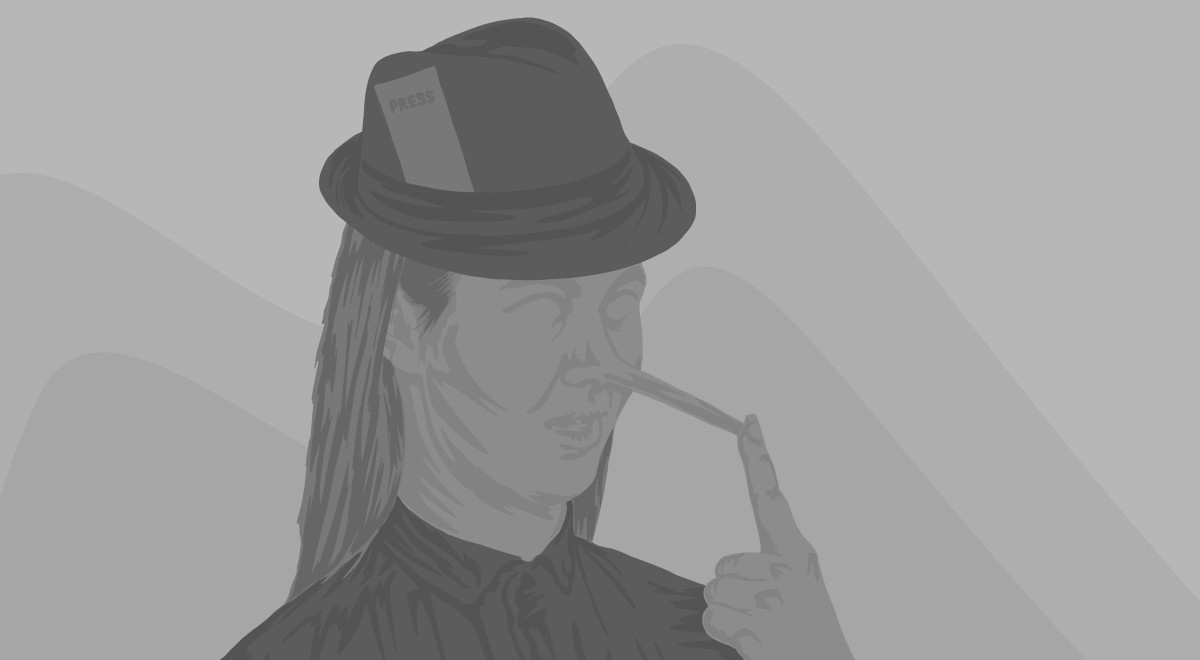Key insights from
The Gray Lady Winked: How the New York Times's Misreporting, Distortions and Fabrications Radically Alter History
By Ashley Rindsberg
|

|
|
What you’ll learn
Ashley Rindsberg’s investigation of New York Times reporting over the past century-plus began when he came across a Times headline from the 1930s reporting that “Poland Invades Germany.” It was not intended to be more than an in-passing mention in a history book, but it floored Rindsberg. Though a longtime reader of the Times and an admirer of the paper’s original charter (“To give news impartially, without fear or favor”), Rindsberg’s exploration of the syndicate has led him to the conclusion that The New York Times dynasty is less concerned with facts than spinning narratives that preserve and promote its clout and financial interests. According to Rindsberg, the costs of the Times’ habitual and intentional misreporting over the past century are incalculably high.
Read on for key insights from The Gray Lady Winked.
|
|
1. Like any dynasty, the New York Times began with a lofty vision that descendants have failed to uphold.
The New York Times is the best-selling paper in the world. The paper has had “All the News That’s Fit to Print” typed out across the front page of each day’s paper since 1897, and the news outlet has been in operation since 1851. It was off to an illustrious start when it reported military victories during the Civil War where other papers did not. Beyond mere politics or ideology, the Times, like the 16th president, understood that the soul of the nation was at stake, and reported boldly and impartially. The Times’ willingness to print the unvarnished truth justly earned it the reputation of journalistic integrity. The paper was the gold standard of the American free press.
But so much has transpired in the decades between its origins and the current day that casts serious doubt on whether the reputation of yore holds true. For more than a century, the paper has been a patriarchal dynasty, passed down from father to son to grandson to great-grandson and so on. When Adolf Och became the Times' controlling shareholder in 1896, he expressed noble aims of impartiality and kept his promise. But as dynasties often do, this dynasty began with a grand noble vision and then devolved as following generations put the “nasty” in “dynasty”: maintaining the power, prestige, and money that the dynasty afforded—even if it involved means that betrayed the founding vision. The company uses a two-tiered stock configuration, which sells shares with no voting rights attached to them to the public, while the other shares, which do carry voting power, stay in the possession of the ruling family. In other words, their decision making power is incontestable. Of course, no institution or person enjoys a mistake-free existence. And reporting accurate news from the four winds on a daily basis is a colossal task. The problem, however, has not been stray mistakes, but a systematic misleading and diluting of the truth to better conform to the whims of celebrity reporters or the interests of the ruling company family.
For a long time, the New York Times was commonly referred to as “The Gray Lady.” The descriptor “gray” was a reference to the tangible honesty and neutrality of concrete. It was trustworthy and reliable. Unfortunately, the moniker becomes less and less fitting as the Times puts gain and power over truth.
|
|
Sponsored by Morning Brew
Become Smarter In Just 5 Minutes

There's a reason over 3 million people start their day with Morning Brew — the free daily email that sums up the latest news from Wall Street to Silicon Valley. Unlike traditional business news, Morning Brew keeps you informed and entertained.
|
|
2. Throughout Hitler’s ascendancy and World War II, the Times bought into and effectively broadcasted Nazi propaganda.
In 1924, the New York Times reported that an Austrian-born man who had served time in a German prison would likely return to Austria and lead a quiet life. Ostensibly jail time had chastened him and he was, in the Times’ own words, "no longer to be feared." The Times was referring to Hitler, and they could not have been more wrong about his post-incarceration plans.
Within two years of his release, Hitler’s messaging had gained significant traction, first in Bavaria and then in the rest of Germany. This was the first of a long line of misleading reports that profoundly misshaped American perception of Hitler and his designs.
For example, in 1939, Hitler’s Gestapo cronies and propagandists coordinated Operation Himmler, which involved Polish-speaking Germans storming a Gleiwitz radio station with guns and shouting in Polish. It was enough to dupe the German people and the world into believing that Poland had attacked Germany, creating the pretext to "retaliate." None of it was true, but the New York Times took the propaganda hook, line, and sinker: from Hitler’s mouth to the Times front page.
This story is more nefarious than a simple case of repeatedly promulgating Nazi propaganda around the world without adding any countervailing voices. The "semi-official news agency" that the New York Times article mentions was one of the main cogs in the Nazi propaganda machine.
The head of National Socialist propaganda Joseph Goebbels and his cronies had a hand in every press publication since 1933, so by 1939 there was no “semi-official news agency”—only official Nazi-approved organs. And the NYT would have known that.
The reporting grew progressively worse over the course of National Socialist ascendancy. One Times correspondent in Berlin named Frederick Birchall wrote in praise of Germany’s hosting of the 1936 Olympics, and bent over backwards to extend benefit of the doubt to the Nazi regime, assuring readers that there was no discrimination in the Olympics (there was) and that Jewish athletes were being trained to represent Germany in competitions (they were not). Birchall took the Nazi officials’ word for it that this was true. Even when the Nuremburg Laws were ratified just two months after, which forbade marriage to or intercourse with Jews, Birchall doubled down on Germany’s lack of discrimination, not just as attributed quotations from Nazi officials, but as fact.
For a decade the Times cast Hitler’s Nazi Germany in the best possible light, even in the face of riots, violence, and takeovers. This did not stop even when Hitler declared war on the United States on December 11, 1941, just a few days after Pearl Harbor attacks. US journalists in Germany were systematically rounded up and sequestered in an old hotel in Bad Nauheim, treated poorly, unable to leave the premises, or communicate with the outside world.
Guido Enderis, chief correspondent from the Times in Berlin was the sole exception to the de facto incarceration of American reporters. As the Nazi undersecretary later wrote, Enderis was left alone “because of his proved friendliness to Germany.”
|
|
3. William Duranty’s airbrushing Soviet slaughter and starvation out of his reports might have extended Soviet longevity and oppression by decades.
New York Times correspondent William Duranty framed the situation in famine-stricken Ukraine bluntly in his 1933 article when he wrote, “But—to put it brutally—you can’t make an omelette without breaking eggs.” Tragically, Soviet efforts to collectivize Ukraine’s farms broke four to 10 million “eggs,” most of them peasants. Imagine the population of Los Angeles being obliterated in just two year’s time.
An abstract concept like class warfare was less pressing to most peasants than finding enough food to survive. Unable to spark the desired peasant revolt, Stalin used terror, intimidation, and violence to bring down the marginally wealthier, land-owning kulaks. Stalin’s heavy-handed tactics did incite revolts, as many peasants refused to till the land. They slaughtered some 30 million cattle and 100 million sheep in protest of the kulakization process that upended the usual agricultural process. Grain production was halved in 1929 and the next several years that followed.
For some reason, Willian Duranty denied any famine. He wrote in March of 1933 that conditions were bad in some places but there’s no famine. By his own admission, Duranty’s investigation was limited to talking with Soviet officials, a number of diplomats, and personal connections.
As the foreign correspondent based in Russia, writing for the world’s most influential paper, Duranty’s words carried weight and carried the public away from the truth. Not only did Duranty report no famine, he went out of his way to contradict reports that there was a famine. When British reporter Gareth Jones wrote a story titled, “Famine Grips Russia, Millions Dying…” Duranty directly interacted with and rejected Jones' account of famine and starvation. There were important differences between Jones’ and Duranty’s reporting: Jones wrote as a first-hand witness. Duranty’s reports were based on hearsay from dubious sources. Asking Soviet commissariats how go the collectivization efforts in the Ukraine is akin to asking Goebbels how German society is faring under Nazism.
Duranty’s name has in more recent times fallen into disrepute and become a byword for journalistic misconduct (though not before winning awards for his reporting on the USSR). It is troubling that Duranty accepted hearsay accounts from Soviet officials when anyone without journalistic training visiting the Ukraine would have immediately recognized the horror. But an even deeper and more troubling question is why Duranty went out of his way to deny atrocities he had no real authority to weigh in on.
It is hard to overstate the influence and respect that the name Duranty enjoyed in the United States and even the world. When Duranty weighed in, the reader would have taken it deadly seriously. Unfortunately, death on a massive scale was delayed in coming to light because of Duranty. His all-too-aptly titled book I Write As I Please written in 1935, which became a bestseller, says it all. The New York Times would later call his reporting "slovenly" but that is too charitable. The insistence on staying ignorant of atrocity was criminal and perpetuated tragedy.
When Duranty met with then-Governor and soon-to-be President Franklin D. Roosevelt on July 25, 1932, one of the major questions was whether the United States should recognize the Soviet Union, a collection of countries acquired by violent force and born of a bloody undemocratic revolution. The Times itself framed the meeting between Duranty and FDR as a chance for friendlier relations between the two nations.
Would things have been different if the American public was aware of mass starvation and brutal repression in the Soviet Union? Would FDR have warmed up to the USSR in the same way? Would the USSR have gone on to control and manipulate the fates of the Eastern bloc’s 300 million souls for another half century?
There are a lot of theories as to how Duranty misled the public even as he was lavishly praised and awarded for his journalism. Most of the theories center on Duranty himself: a Communist sympathizer, shrewd opportunist, and cavalier maverick. The theories tend to overlook the larger picture, which links Duranty’s failures to the more fundamental failure of the New York Times, which let him write as he pleased.
Whether because they sympathized with Duranty’s position, were blinded by the light cast by Duranty’s stardom, or some other reason, supervision was glaringly absent. And as the accolades and acclaim continued to grow around the Duranty name, the Times had incentive to support their journalist’s rosy depictions of a Soviet paradise, or at least keep looking the other way as Duranty talked it up.
The New York Times did not seem troubled by the dissonance between the voices of exiled Soviets and Duranty’s. Or the fact that exiles were documenting stories they had seen first-hand (of farm equipment rusting in fields and buildings boarded up), whereas Duranty’s reporting of witness testimonies were conspicuous in their absence. Neither did they seem to find it curious that dissenting voices never entered Duranty’s articles.
|
|
|
|
4. The NYT’s backing of the 1619 Project, even in the face of glaring inaccuracies and pressure from both sides, shows ideology more than objectivity.
Throughout the second half of the 20th century and into the 21st, the NYT has continued to report on and frame major world events in a way that puts impartiality on the backburner, sacrificing journalistic integrity to further some other agenda. From the Soviet Union’s repression of its own people to Hitler and the Holocaust to Fidel Castro and Vietnam, the New York Times repeatedly fails to deliver simple unadorned truth, “without fear or favor.”
The most recent batch of systematic failures began August 14, 2019, when the New York Times’ Sunday magazine devoted all 100-plus pages of the issue to America’s legacy of slavery. The editor of the magazine wrote that, “The goal of the 1619 Project is to...reframe American history by considering what it would mean to regard 1619 as our nation’s birth year. Doing so requires us to place the consequences of slavery and the contributions of black Americans at the very center of the story we tell ourselves about who we are as a country.”
This was a chance to give more narrative space to other historical events that have often gotten short shrift. But more than adding to the story, the NYT had more ambitious aims in mind: reframing America’s founding all together. Nikole Hannah-Jones, the reporter who originated and organized the 1619 Project, opened her essay with the bold, if vague, assertion that, “Our founding ideals of liberty and equality were false when they were written.” By placing 1619, the year when the first slave-bearing ship came to America, at the center of the origin story, rather than the 1776 telling that places severance from the British and a tradition of equal rights at the fore, the whole tenor of the story changes. It’s inverted, even. Scholars wrote articles that laid everything from junk food to deficient health care to modern American capitalist forms to traffic jams at the feet of the slave system.
The 1619 Project’s reframing fundamentally changes America’s origin as a fight for freedom from tyranny to a tyranny still to be thrown off. The country no longer began as a city on a hill, exemplifying freedom, but a bastion of oppression and exploitation.
The August 14, 2019, magazine was a maiden voyage, but it has been followed up with a fleet of textbooks and curricula for classrooms. The reframing feat that the NYT is attempting is an extremely ambitious project. Maoist China and Soviet Russia did so, but over generations and at the cost of millions of lives. The point is to give a sense of scale and remind ourselves that retelling a nation’s history and getting the nation to accept the new version is a massive undertaking and has proven costly when attempted.
The Times is no stranger to controversy, but what made this different was that it provoked deep ire from both sides. Numerous reputable Ivy League historians specializing in the antebellum South, slavery, and the Civil War weighed in and found many articles deeply deficient and overly simplistic.
This all raises the question: “What happened?” Ideally scholarship goes through a vetting process, where knowledgeable peers critique ideas and help each other shore up weak arguments, point out bias and blind spots. The evidence suggests that the NYT editors did not appear interested in this process of rigorous fact checking, but published what they wanted to publish. One Stanford historian, while distancing herself from some of the historians who first weighed in as too soft on slavery’s impact, said that she emphatically rejected some ideas that NYT editors put forward, like the argument that the American Revolution was an attempt to secure the slave trade. The Times published an article to that effect anyway. And not only is the Times doubling down and rejecting the advice and blowback from concerned historians (which Times editors belatedly admitted they were not), reporters at the Times have continued to promote an extensive program for the schools including textbooks and curricula.
The Enlightenment of centuries’ past advocated a skepticism that asked why and how. It was doubt that fueled scientific inquiry and discovery. Critical theory by contrast not only questions and doubts accepted knowledge systems, authority, and undergirding psychological assumptions, but posits answers, filtering life through an oppressor-oppressed dichotomy.
The Times is a private company and thus well within its rights to produce these materials in addition to their initial August 14, 2019, publication. But these are the kinds of pieces that reveal a strong ideological bent. Persisting in ideology further compromises an already sullied tradition of objective reporting. Proceeding with the 1619 project in schools despite copious scholarly objections shows their cards. They are choosing to play with a deck loaded in favor of certain ideals and pitted against others.
Clearly, the Gray Lady winked (or blinked, or deliberately closed her eyes) while Project 1619 was being developed. This is a far cry from reporting impartially, “without fear or favor.”
|
|
This newsletter is powered by Thinkr, a smart reading app for the busy-but-curious. For full access to hundreds of titles — including audio — go premium and download the app today.

|
|
Was this email forwarded to you? Sign up here.
Want to advertise with us? Click
here.
|
Copyright © 2025 Veritas Publishing, LLC. All rights reserved.
311 W Indiantown Rd, Suite 200, Jupiter, FL 33458
|
|
|